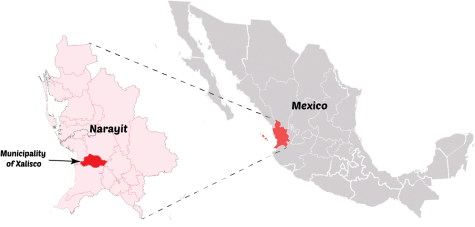Book Breaks the Silence
"Dreamland" author joins campus community in battling heroin crisis
January 27, 2016
It was the only time he had ever lied about being a reporter.
After living in Mexico for a decade, Sam Quinones should have been comfortable returning to the country, but this time was different.
It was 2009, and Quinones was visiting a specific area of Mexico- a small county called Xalisco located in the state of Nayarit.
Quinones’ visit was strictly business, and although the natives were unaware of his motives, he had traveled there to track down the dark roots of the black tar heroin trade.
His findings, combined with countless interviews with DEA agents, medical professionals, law enforcement officials and families affected by the drug led to the creation of his book “Dreamland: A True Story of America’s Opiate Epidemic”.
NKU Provost Sue Ott Rowlands wants to create conversation about the chilling stories that Quinones communicated so eloquently.
That is the reason Ott Rowlands has been coordinating Quinones’ visit to campus since last summer.
“Addiction wasn’t on the radar, and now it ranks our top population health crisis,” Ott Rowlands said.
Ott Rowlands read “Dreamland” when it first came out in April 2015, and she knew right away that it was an important story for Northern Kentucky.
She felt compelled to reach out to Quinones, so she contacted him in August, just four months after “Dreamland” was published.

Provost Sue Ott Rowlands reviews her signed copy of “Dreamland.” She has been coordinating Quinones’ visit to campus since last summer.
“I think Sam has the power to attract an audience, which sounds commercial in some way, but it’s really very pragmatic,” Ott Rowlands said. “If we can’t get people together, we can’t have that kind of impact and we can’t invite conversation.”
Ott Rowlands is working with NKU faculty, staff and the community to organize a semester-long series of events centered around the heroin crisis.
Mark Neikirk, director of the Scripps Howard Center for Civic Engagement, has invited 20 individuals from the community to participate in Quinones’ visit.
The events begin Feb. 1 with a panel discussion on media coverage of heroin and a writing workshop led by Quinones. Other events range from discussions from faith-based organizations to public policy, and culminating in Quinones’ three-day visit April 18-20.
It will be the first event hosted by NKU’s Health Innovation Center, a facility dedicated to serving population health through transdisciplinary study that will open in the fall of 2018.
“As we’ve been developing the concept of the Health Innovation Center, we know that the Commonwealth gave us $97 million because they believed in NKU’s ability to have a vision, see it through, and make it a reality,” Ott Rowlands said.
“And that vision is to address the critical issues in population health, facing not only our region but really the country and the world. The most critical issue, some would say, facing our regional population is addiction.”
THE CREATION OF “DREAMLAND”
Perhaps no one knows how addiction has crippled Northern Kentucky and southern Ohio quite like Quinones.
Quinones covered the Mexican drug trade when he was a reporter for the Los Angeles Times. Through his reporting, Quinones came to realize the booming business centered around black tar heroin.
When he visited Xalisco county in 2009, Quinones discovered just how effective the system was for the people there. Though there was not tremendous wealth, he knew that this area of Mexico was unlike any place he had seen.

Xalisco, Nayarit is a small part of Mexico that Quinoes attributes to a booming black tar heroin trade.
“It was scary as hell,” he said. “I mean, I probably exaggerated it. I probably didn’t need to feel that scared, but all you had to do was read the headlines. And again, I’m not a brave guy, I just thought that I had to go down there to see the place and get a sense for it.
“It was very good that I did because it gives me an idea of this system at work. This system is not about creating ungodly riches for a tiny few people. It’s about creating some wealth for many, many, many people. And that’s why it’s effective, and that’s why it’s successful.”
Quinones said he learned the most about Xalisco, not by interacting with natives, but by observing.
The heroin was being transported across the border to cities that were inconspicuous, where Mexican traffickers could quietly drive around with balloons of heroin in their mouths, delivering addicts their fix.
Portsmouth, Ohio is one of these areas. Just 100 miles from Cincinnati, Quinones described Portsmouth as the former home of a pill mill operation, where doctors would prescribe large amounts of opiate painkillers to anyone who appeared to be in the least bit of pain.
When it became more difficult for addicts to get prescription pain pills, they turned to black tar heroin, a substitute that Mexican drug traffickers were more than willing to provide.
Drug traffickers flocked to cities like Portsmouth all over the country. Quinones knew that the southern Ohio and eastern/northern Kentucky area were important for his book, as the pill mill created a new breed of heroin addicts.
Prior to writing “Dreamland,” Quinones had never been to Northern Kentucky or southern Ohio. He said in order to experience the drug’s impact on the region, he traveled to the area several times to talk to families who were all too familiar with heroin’s grasp.
COMING OUT OF THE SILENCE
Quinones said that although he was able to collect enough stories to produce “Dreamland,” the vast majority of the people he encountered did not want to share their experiences.
“It was a topic that no one was talking about,” Quinones said. “This was also huge. Nobody at that point, when I was writing this book, was talking about this except a few parents. And not all the parents with kids who died, a lot of parents with kids who died were very quiet about it.
“They didn’t want to talk about it. Very rarely would you find a parent who wanted to talk about it, and so I felt like this needed to be a book that got people talking. That was a major goal of this book. It had to be able to do that, and I think it did. I’m pretty proud of its effects on this issue.”
It is Ott Rowland’s hope that Quinones’ visit to campus will fuel the existing impact of his bestseller.
“We have an opportunity to have a voice that could make a real difference,” Ott Rowlands said. “If we can bring the right folks together and we can somehow energize and educate enough people, then we might have a chance to contribute to solutions.”
Neikirk also feels that getting together as a community will help eradicate the embarrassment that is often associated with addiction.
“The two things that really come across a lot are, don’t be silent, that this epidemic thrives in silence,” Neikirk said. “We need to talk about it and associate it with that to take away the shame. This is a disease. Addiction is a disease. Heroin addiction is a disease. It’s not a matter of shame if you have cancer or the flu, and it shouldn’t be a matter of shame that you are sick with addiction. We need to talk about that as a community and understand that.”
Neikirk said that in addition to easing the stigma of addiction, he hopes Quinones’ discussions will benefit those who have not experienced the effects of the drug.
“People need to be aware of it. People who have been touched by it, or are professionally involved know about this epidemic and the nuisances of it, and what are effective strategies, but the community at large does not. We learn about it maybe too often when it touches us, rather than beforehand. So can we be an agent for more dialogue and more understanding?”
THE HEALTH INNOVATION CENTER: “MORE THAN A BUILDING”
Along with facilitating a better understanding of the heroin crisis, Ott Rowlands feels this opportunity will serve as a catalyst for what is to come from the Health Innovation Center.
She said that she and other university officials involved in academic programming are in the process of identifying signature areas of research strength, and she believes that a research area surrounding addiction science will be a significant initiative of the Health Innovation Center.
“The Health Innovation Center isn’t a building,” Ott Rowlands said. “The Health Innovation Center is an initiative… it’s programming, it’s people. Yes, it’s a facility, but it’s work. It’s work and effort and commitment that happens because NKU is an engaged university.”
Ott Rowlands hopes that the addition of addiction science will not only increase the level of knowledge on the topic, but that it will also provide research that will aid those battling with heroin addiction.
“The main thing that is between us and making a real improvement… is we still see drug addiction as a crime and not a disease. As any police officer will tell you, we can’t incarcerate ourselves out of this problem.”
Neikirk agrees that incarceration is not a viable solution. He said he has noticed an interest from law enforcement officials on how to handle situations involving heroin addiction.
“Nobody’s suggesting that heroin trafficking or drug trafficking shouldn’t be a crime at various levels, but the person who is addicted to heroin is not well served just by being locked up,” Neikirk said. “Hence you’re beginning to see treatment at the jail and a pretty strong interest from the judicial community on how best to deal with it.”
Quinones said that while he is in Northern Kentucky, he is willing to speak with anyone who is interested in creating possible solutions to combat the area’s problem.
“Basically I’m there to try to be a part of a larger discussion,” Quinones said. “I’m there to tell people what I know, but also maybe to use the book the way that it has been most effectively used, as a way of just getting people to talk in general about these issues, so that it just opens up discussion in a way that maybe hasn’t happened before.”
Neikirk believes Quinones’ presence on campus will enhance the region’s understanding of the crisis it is facing. He hopes that Quinones will inspire members of the community to work together to find a solution.
“We have as a community, understood the devastation and tried to respond to it, but the work is not finished,” Neikirk said. “I think that Sam’s visit here will just elevate this as a community cause. There’s a lot of attention in our community on the topic and there should be and there needs to be, and it needs to be ongoing until we win.”

